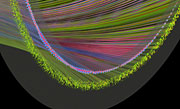- Number 295 |
- September 14, 2009
PPPL plasma turbulence simulation creates award-winning movie

electron-temperature gradient
cross section
Scientists at the DOE Princeton Plasma Physics Laboratory (PPPL) have developed a simulation code that accurately models global turbulent transport of plasma using the full geometry of the tokamak device. Plasma is a hot ionized gas that is the fuel for fusion energy production; a tokamak is a type of fusion machine. The large-scale simulation is of microturbulence driven by changes in the electron temperature across the plasma in PPPL's National Spherical Torus Experiment (NSTX). "The simulation uses the real experimental profiles of a specific NSTX shot, or discharge," says PPPL computational physicist Stephane Ethier. Ethier works on a team led by PPPL physicist Weixing Wang, who created the code. Ethier's visualization colleagues Kwan-Liu Ma, Chris Ho and Chad Jones from the University of California, Davis, used the simulation data to generate a movie, "Visualization of Electron-Scale Turbulence in Strongly Shaped Fusion Plasma." During the annual Scientific Discovery through Advanced Computing (SciDAC) meeting this summer, the DOE honored Ethier and the UC Davis team by choosing the movie as one of 2009's ten best scientific visualizations. "The movie explores the structure of the electrostatic potential at a certain time during the simulation by 'flying' around the torus," Ethier explains.
[Patti Wieser, 609.243.2757,
pwieser@pppl.gov]
